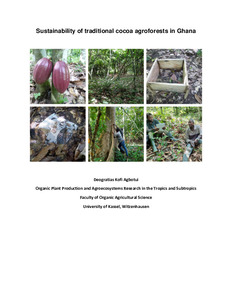| dc.date.accessioned | 2022-08-29T08:28:02Z | |
| dc.date.issued | 2022 | |
| dc.identifier | doi:10.17170/kobra-202208246754 | |
| dc.identifier.uri | http://hdl.handle.net/123456789/14107 | |
| dc.description.sponsorship | DAAD | |
| dc.language.iso | eng | eng |
| dc.rights | Attribution-NonCommercial-NoDerivatives 4.0 International | * |
| dc.rights.uri | http://creativecommons.org/licenses/by-nc-nd/4.0/ | * |
| dc.subject.ddc | 630 | |
| dc.title | Sustainability of traditional cocoa agroforests in Ghana | eng |
| dc.type | Dissertation | |
| dcterms.abstract | Cocoa (Theobroma cacao L.) is an important agricultural commodity that is important to the economies of many countries in the world. Due to cocoa’s dependence on fertile forests soils, its production is a major cause of deforestation and soil degradation in producing countries. When grown in agroforestry systems it can conserve biodiversity, sequester carbon (C), and maintain soil fertility. There are many cocoa agroforests which are managed without synthetic agrochemicals. Because organic cocoa certification is now gaining attention in Africa, studies comparing cocoa agroforests under organic management and conventional systems are scarce. To fill knowledge gaps comparing the performance of these management systems, this thesis aimed at comparing the profitability (Study 1), soil fertility (Study 2), and internal nutrient cycling (Study 3) between cocoa agroforests under conventional and organic management. All three studies were conducted in Suhum Municipality in the Eastern Region of Ghana using four villages (two villages per management type).
Study 1 aimed at assessing profitability of the two managements with or without C payments using 100 farmers per management. Net present value of cash flow (NPV), benefit cost ratio (BCR) and modified internal rate of return (MIRR) were used as profitability indicators. Profitability indicators were recalculated under three assumed scenarios: 300% interest rate from 8% to 24%, 20% yield loss, and 10% increase in cost. Results showed conventional management having 13% greater NPV than organic management. Managements were most sensitive to 300% interest rates, but organic farms were more sensitive than conventional farms. Management had no effect on C sequestered. Theoretical C payments at low price (7.5 € t-1 CO2eq-1) made organic management reduce their NPV deficit to conventional management from 13% to 7%. But at a high C price (42 € t-1 CO2eq-1) NPV was similar for both management systems.
Study 2 assessed management effect on soil physico-chemical and microbial properties at depths 0–10 cm and 10–30 cm. Management had no significant effects on soil physico-chemical properties measured. Low chemical properties and microbial biomass C and N observed in Con 2 were due to low clay content. Pairwise comparison in the topsoil showed that organic management had a 35% significantly lower metabolic quotient (qCO2) than its conventional counterpart, whereas in the subsoil management had no effect on qCO2. Soil organic C, clay, and pH had a positive effect on microbial biomass C and N.
Study 3 compared litterfall and cocoa leaf decomposition between conventional and organic managements. Monthly litterfall was collected using litterboxes whereby decomposition was studied using a litterbag technique for 12 months. Average annual litterfall was 8 t ha-1 yr-1. Management had no effect on annual litterfall, however, during dry season litterfall was 60% significantly greater than in the rainy season. The rate of cocoa leaf decomposition in organic villages was on average 16% greater than in conventional villages.
The results showed that it will be technically easy for conventional cocoa agroforesters to adopt organic management due to major similarities between both systems in Suhum Municipality. On the more general level the results show the feasibility of using traditional cocoa agroforests in REDD+ projects due to their ability to sequester C and provide income for farmers. | eng |
| dcterms.accessRights | open access | |
| dcterms.creator | Agbotui, Deogratias Kofi | |
| dcterms.dateAccepted | 2022-07-28 | |
| dcterms.extent | xiii, 107 Seiten | |
| dc.contributor.corporatename | Kassel, Universität Kassel, Fachbereich Ökologische Agrarwissenschaften | |
| dc.contributor.referee | Bürkert, Andreas (Prof. Dr.) | |
| dc.contributor.referee | Möller, Detlev (Prof. Dr.) | |
| dc.contributor.referee | Schlecht, Eva (Prof. Dr.) | |
| dc.contributor.referee | Gornott, Christoph (Prof. Dr.) | |
| dc.subject.swd | Ghana | ger |
| dc.subject.swd | Kakaoproduktion | ger |
| dc.subject.swd | Agroforstwirtschaft | ger |
| dc.subject.swd | Nachhaltigkeit | ger |
| dc.subject.swd | Bodenfruchtbarkeit | ger |
| dc.subject.swd | Wirtschaftlichkeit | ger |
| dc.subject.swd | Nährstoffkreislauf | ger |
| dc.type.version | publishedVersion | |
| kup.iskup | false | |
| ubks.epflicht | true | |


